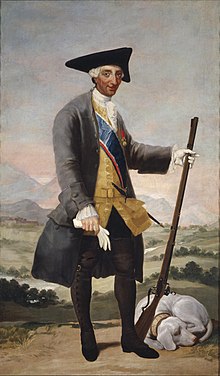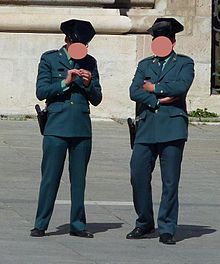Tricorn




The tricorn is a type of hat that was initially made of felt and with the wide brim folded upwards looking for the crown and forming three peaks, but the name lends itself to confusion or controversy because the prefix "tri" infers three "horns", in controversy with the two real peaks that it has today and even since the last third of the century XVIII, when the front peak is forced to adapt to the front contour of the crown and physically leaving only two lateral peaks. This type of hat was called 'three-cornered hat worn in battle', which is exactly the type of three-cornered hat that Napoleon popularized and that the Marquis of Esquilache wanted to make fashionable.
The word tricorne is a foreign word adopted from French (tricorne-trois cornes) or from English (tricorn-three corner), as a synonym for three-cornered hat, when in those two languages its meaning is not strictly hat, but "tripicudo" or "triesquinado", so its adoption in Spanish has not been successful and has led to numerous errors, many of which still persist regarding the conception we have of what the word. In the official documentation of the Civil Guard this term has never been used, always referring to the generic word hat or its complete description: three-cornered hat.
On the other hand, in the military historiographic literature of the XVIII and XIX centuries, more Hispanic terms such as pointed hat are also used. or dazzled; both in the Military States of the various years, and in the Albums of the Infantry and Cavalry of Don Serafín María de Sutton y Abbach –Count Clonard–, which are an indisputable reference for any student of Spanish uniformology.
History
The round wide-brimmed hat (chambergo, felt or chapeo), worn by soldiers in the XVII century, It is the origin of the three-peaked wing when, towards the beginning of the 18th century, this wide wing was raised by three points (one on each side and one at the back), leaving it with a triangular base shape (the military fashion of the time was marked by the uses of the French armies). In the last third of this century the elevation of the peak or "candil" front that little by little becomes more and more adapted and tight to the front of the cup (placed in battle) to free sight and movements in the use of weapons.
As a military garment, in its two variants with three and two peaks – real –, it was used throughout the 18th century and it disappeared from almost all Spanish uniforms with the beginning of the 19th century. In its most popular period, it was also for civil use, especially in the North American colonies. The Esquilache mutiny of 1766 was triggered by the faction of capes and hats with which it was intended to put an end to the custom of wearing long cloaks and hats that hid the face.
This three-cornered hat was usually worn with the point forward, like the Chelsea Pensioners of the United Kingdom and the patriots of the American Revolution. The top is low, unlike the caps worn by Puritans or the top hats of the 19th century.
There were very simple tricorns and also extremely extravagant ones, even incorporating feathers, ribbons and braids in gold or silver. In the United States, some sports teams use them to commemorate their independence. The tricorn would later evolve into the bicorn when it loses its three peaks and when there are only two left, the two remaining wings begin to adhere equally to the crown. This new type of hat behaved both "pointed" from back to front, as if crossed, thus leaving its two peaks on each shoulder. Even in some illustrations from the time they can be seen divided or crossed.
Tricorn of the Spanish Civil Guard





The old Institutes of Carabineros and the Civil Guard were created by Royal Decrees of March 9, 1829 and March 8, 1844 respectively, and were organized by Field Marshals José Ramón Rodil and Francisco Javier Girón, Duke de Ahumada, first general directors of said Corps.
The Law of March 15, 1940 organizes the Civil Guard Corps, centralizing the missions entrusted to the old Institutes. The Civil Guard was founded as a militarized Corps.
The tricorn hat of the Civil Guard has survived more than a century and a half of history of the Benemérita with just a few changes in dimensions and a peculiarity that began as an economical solution. It characterizes Spain and the Civil Guard and is no longer made of felt but of a black and shiny material (not patent leather but vinyl) which is an evolution of the rubber that was used to cover and protect the old hats from the inclement weather to which they were exposed. those of the first Civil Guards were subjected in their long and suffering services in the open. This military head garment was not created by the Duke of Ahumada, founder of the corps in 1844, but was proposed for the cavalry forces, while a morrion or cap similar to a ros was proposed for the infantry. It was Queen Isabel II, at the proposal of General Narváez, who decided to extend the use of the tricorn to the force of both weapons.
That old black felt hat, trimmed around the entire contour of its wide brim with a braid of white thread, with its rear brim almost straight and elevated, and the front brim tight and curved around the front of the crown, with its only two almost horizontal peaks over each ear of the Civil Guard wearing it, it was a garment that conferred elegance and showiness, even presence and respect, but that was not at all economical and very sensitive to rapid deterioration due to the action of the sun and the weather. As a consequence of this, Ahumada soon decided to authorize the use of rudimentary rubber covers that the women of the Guards themselves could make, although only for winter services in the open or at night; Another white cover for summer was authorized not long after.
These covers were attached to the "gala" closing under each peak with two small buttons, on each side. The black felt hat that went underneath also had a white braid loop on the front, although narrower, that held a cockade, cucarda or cocarda (scarlet first and with the national colors later) and was finished with a button that fixed it on the head. middle of the front blade. The protuberance of this button was perfectly noticeable with the case on and this is the reason why current tricorns maintain this front button in addition to the four small black buttons under the peaks.
As the years went by, the use of hats was established whose frame could be made of thick cardboard or cork and which, once the rubber cover was fixed - and well stretched - would imitate "in a whole" to the gala ones, which were only continued to be used with this type of uniform. After the 50s of the XX century, rubber gave way to plastic – vinyl – which gave it greater shine and appearance.
Patent leather is a finish that is given to leather, so the hats of the Civil Guard have been patent-lacquered, to imitate its color and shine, but never patent leather, because they have never been made with this material.
Things have been written about the front buoy such as that it is reminiscent of the front peak, a third peak that has also been sought in the initial curved shape of the rear blade or in the cup itself, as other pilgrims have also written arguments such as that the rear blade is flat so that the Guards could sleep with it on. That it is a derivative of the bullfighter's montera and that its shape evokes a bullring. Which is made with bull skin or which is derived from a so-called 'half-cheese hat'.
That the shape of the Civil Guard hat has not changed substantially since its foundation, except with regard to its general dimensions, is proven by numerous graphic documents reliably dated prior to its first variation in 1860, among others a photograph that is considered the first taken in history of a Civil Guard in Reinosa between 1855 and 1857 by the English railway engineer William Atkinson and which is preserved in the General Archive of the Royal Palace of Madrid of the National Heritage.
At the beginning of the post-war period, the uniforms were modernized in accordance with the regulations established for the rest of the army, and the new Uniformity Regulations of 1943 published by the Ministry of the Army on January 27, 1943 can be seen. rules that will govern the Army, which includes the Civil Guard.
With the Uniformity and Equipment Regulations for the Army of 1943, the gala tricorn hats went from being chevroned or trimmed with white thread ribbon to yellow silk, also varying the design of the chevron, which from now on would be made of oak leaves.. Regarding headwear, the black or tricorn hat remains and remains the most representative of the Corps.
Until 1987 the guards had to purchase their own uniforms. Starting that year, the Institute management purchases the uniforms with its funds and delivers them to the guards.
The first units of the Civil Guard that stopped using the tricorn were the traffic units, which used helmets or flat caps, and the anti-terrorist units. Subsequently, this garment was also eliminated among the majority of those who covered motorized rural patrol services and in the Special Intervention Unit.
The internal resistance to the replacement of the tricorn hat led to the failure of several attempts by the political authorities to change that garment which, although it has historical roots because it began to be used in 1859, only 14 years after the creation of the Civil Guard, It is not practical for the tasks performed by guards.
In 1989, Luis Roldán, general director of the Civil Guard, issued the General Order that replaced the tricorn as a general garment in the Civil Guard. Its use was maintained for guards serving in embassies and important public buildings, as well as those assigned to airport security. In addition, the guards could continue to wear the tricorn on their walking uniform and on parades.
Contenido relacionado
Acholi
Chillida-Leku
Apache (disambiguation)